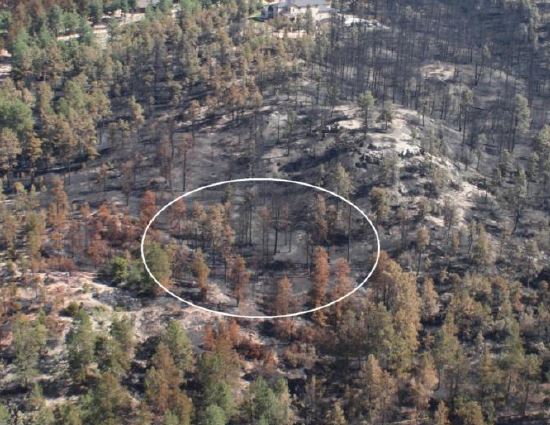Some people assume the federal government can do nothing right and use that as an excuse to create fear and rationalize their views. Concerning the national parks and national forests in his state that are owned by the citizens of the United States, a state senator in Colorado, Steve King, has said “absentee landowners” are managing the federal lands.
Senator King and others who may know little or nothing about wildland fire behavior see trees affected by insects (see the tag “beetles”) and assume the forest is now subject to unprecedented explosive forest fires. There is not complete agreement on this, but at least two recent studies have concluded that beetle killed trees do not substantially increase the risk of active crown fire, at least in lodgepole pine (Pinus contorta) and spruce (Picea engelmannii)-fir (Abies spp.). We said the same thing as early as three years ago. Our view is that the resistance to control of a forest fire would increase somewhat one to four years after a beetle outbreak, during the red needle stage, and then would decrease since the crown fire potential would dramatically decline.
Senator King’s opinion about absentee landowners is over the top, but he uses that argument to justify his state’s acquisition of an air tanker and helicopter fleet to better attack wildfires in Colorado. While his goal may be laudable, his tactics are not. And keep in mind, aircraft do not put out fires. Under ideal weather, fuel, and topography conditions, they can slow down a fire providing firefighters on the ground an opportunity to suppress it. If those conditions do not exist, such as during strong winds, aircraft are virtually useless as a fire suppression tool.
Below is an excerpt from an article written by the senator, and following that, a portion of a newspaper’s editorial in response.
…Absentee owners are allowing brush and beetle-kill trees to collect to the point of criminal negligence, putting all property owners at risk of being victims of a catastrophic wildfire.
The absentee owner here is the federal government: 36.6 percent of Colorado land is under the control and “ownership” of the federal government. A very high percentage of dead federal beetle-kill trees that have blown down now are surrounding Colorado’s precious life sustaining water sheds.
If any other Colorado land owner allowed their property to de-evolve to the state of federal lands in the WUI and around our water sheds, the state of Colorado would declare the land blighted and exercise eminent domain to take that land under state control. We are in a critical race against time to remediate the land before it is too late for our water, air and land to be saved from the specter of a catastrophic wildfire…
Grand Junction’s Daily Sentinel responded to Senator King’s remarks. Below is an excerpt:
…State Sen. Steve King’s latest offering – “Don’t count on federal landowners to aid in fighting wildfires in Colorado” – epitomizes the incoherence of Republicans’ pandering policy prescriptions.
The federal government manages 23 millions acres of wilderness, National Forest, and BLM lands in Colorado – where fires are often naturally occurring regenerative events.
Coloradans have chosen to build homes adjacent to those lands – ignoring the inherent risks of doing so, which are apparently increasing as a result of global climate change.
King conveniently places the onus of fire suppression responsibility on the public side of the “wildland-urban interface”—rather than on “urbanites”—and falsely insinuates that the federal government is “absent” when wildfires originate on federally-managed lands.
Moreover, King curiously does not advocate a commensurate exercise of “eminent domain” against absentee private landowners who neglect their property, counties that refuse to enact sensible zoning ordinances, and/or individuals who fail to demonstrate “personal responsibility” by acquiring adequate and actuarially-priced fire insurance.
Instead, King calls on Colorado’s “government” to insure those “free riders” by imposing increased tax burdens on more prudent citizens who opt not to assume the risk of closely locating near the viewsheds afforded by Colorado’s scenic landscapes, while begging the question of how many firefighting aircraft are needed and who would pay for them…






